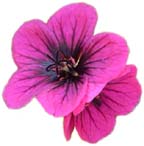|
Cultivating small spacesby AMY STEWART SEVERAL MONTHS AGO, A READER asked me for some suggestions about gardening in small spaces. I told him I'd answer him in a future column. It's taken me a while to get around to it, but perhaps the delay was worthwhile. Fall is the perfect time to redesign a garden, whether it's large or small. You can move plants around this time of year, make divisions, and take cuttings, then let the rainy winter weather give the garden the deep soaking it needs to get reestablished. So here are my suggestions for creating something extraordinary in a small space. Think Big. Don't assume that having a small garden means that you should fill it with small plants. Skip the pansies, primroses, and impatiens. These flowers only grow to about 6 inches tall and will yield a miniature garden, the sort of thing you stand over and look down upon. Remember that a garden is more than a patch of dirt to be filled -- a garden includes the airspace above that patch of dirt. Go for tall plants that will make a statement. I particularly like Verbena bonariensis, a tall purple verbena with stiff, narrow stems and clusters of deep purple flowers. It's a striking, architectural plant that is light and airy, so it won't conceal what's behind it the way a large shrub might. It also attracts butterflies and is easy to propagate. A friend of mine planted an enormous salvia, S. gesneriiflora "Tequila" in her small patio garden. It grows to over 6 feet tall, sports deep red trumpet-shaped blossoms almost year-round, and is a magnet for hummingbirds. Choosing one large, striking plant to dominate a small space works well -- as long as it's a plant that you genuinely love. I've also seen small spaces filled with sunflowers and hollyhocks. One disadvantage to this planting scheme is that it peaks in summer and dies off in winter. But if your goal is a brilliant summer display, go for enormous sunflowers like "Giant Greystripe," or maybe the perennial Maximilian sunflower and hollyhocks in shades of deep red and purple. It'll knock your socks off.
Vertical Integration. Use tall structures like an arbor, a lattice, or a sculpture to bring height and intimacy to a small garden. Climbing roses, flowering vines and annuals like scarlet runner beans or sweet peas can enhance a small garden without taking up too much space on the ground, as long as they're given something to climb. And it doesn't have to be expensive--I've seen an old ladder, a bamboo teepee and even rusted rebar fashioned into a structure for plants to climb. Form Over Function. Small gardens are a great place to try out a formal garden, the sort of thing that would be too much labor on a grander scale. Plant in stripes, squares, triangles, or Celtic knots. Get a book on formal European gardens and find just one bed that you can replicate. Consider a formal herb garden edged in lamb's ears and filled with tidy rows of sage, thyme, chives and parsley. Add tulips and fall crocuses at neatly spaced intervals between the plants so you'll have some variety in spring and fall.
Dirt, Dirt and More Dirt. The best thing you can do to get a small garden off to a good start is to improve the soil. Patio gardens and sidewalk strips may be filled with topsoil that was brought in when your home was built. That kind of soil is not likely to be high in nutrients, and if you're packing a large number of plants into a small space, you'll need good soil to help the garden reach its potential. Dig out the first foot or two of soil and mix it well with the best compost you can buy. Add another thick layer at the base of your plants each fall. And encourage your plants to grow together to form a canopy that covers the soil, which will help preserve moisture and prevent runoff. Make It Count. There's no room in a small garden for runners-up, for plants you merely tolerate. Everything counts -- every leaf and flower should move you. So above all, plant what you love. garden-related announcements and news to Amy Stewart. IN THE NEWS | COVER STORY | GOOD NEWS | CALENDAR © Copyright 2003, North Coast Journal, Inc. |


 Striking
Color Combinations. One drawback
to a small space is that you do have to make some choices --
there just isn't room to plant everything. A carefully chosen
color scheme can really make an impact in a small space. Also,
the color of the foliage matters more than it might in a larger
garden, where the eye has more to take in. Consider silver foliage
-- artemesia, lavender, or artichokes -- with deep purple flowers.
Or try chartreuse foliage -- helichrysum "Limelight,"
breath of heaven, or geranium "Ann Folkard" -- with
magenta flowers. Bronze foliage such as canna, some of the heucheras,
and some of the ornamental grasses look great with orange flowers.
These color schemes are too limited to carry out on a large scale,
but they can look great around a patio or a narrow planting strip.
Striking
Color Combinations. One drawback
to a small space is that you do have to make some choices --
there just isn't room to plant everything. A carefully chosen
color scheme can really make an impact in a small space. Also,
the color of the foliage matters more than it might in a larger
garden, where the eye has more to take in. Consider silver foliage
-- artemesia, lavender, or artichokes -- with deep purple flowers.
Or try chartreuse foliage -- helichrysum "Limelight,"
breath of heaven, or geranium "Ann Folkard" -- with
magenta flowers. Bronze foliage such as canna, some of the heucheras,
and some of the ornamental grasses look great with orange flowers.
These color schemes are too limited to carry out on a large scale,
but they can look great around a patio or a narrow planting strip. Go
Natural. Even a small garden can
be a haven for birds and butterflies. I particularly like Noël
Kingsbury's book Natural Gardening in Small Spaces; it's
packed with ideas for creating meadows, bogs and habitats of
all kinds. Although his idea of a small space is a little different
from mine, most of his designs can be replicated on a tiny scale.
He includes a great section on establishing a meadow, which is
never easy in a large area where weeds and existing grasses can
out-compete wildflowers. But on a smaller scale, it's easier
to keep on top of weeds during the first few years while native
grasses and flowers take over. Also, if you're after something
low-maintenance, a water-wise perennial garden of California
natives like ceanothus, Cleveland sage and mimulus works well
on any scale.
Go
Natural. Even a small garden can
be a haven for birds and butterflies. I particularly like Noël
Kingsbury's book Natural Gardening in Small Spaces; it's
packed with ideas for creating meadows, bogs and habitats of
all kinds. Although his idea of a small space is a little different
from mine, most of his designs can be replicated on a tiny scale.
He includes a great section on establishing a meadow, which is
never easy in a large area where weeds and existing grasses can
out-compete wildflowers. But on a smaller scale, it's easier
to keep on top of weeds during the first few years while native
grasses and flowers take over. Also, if you're after something
low-maintenance, a water-wise perennial garden of California
natives like ceanothus, Cleveland sage and mimulus works well
on any scale.